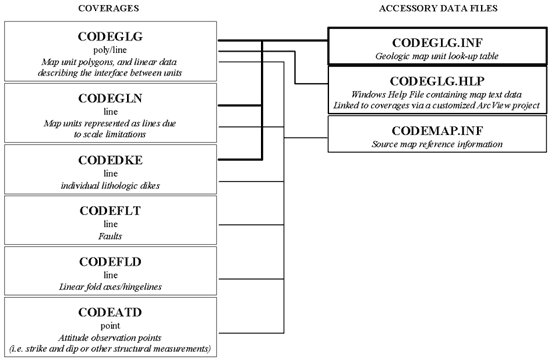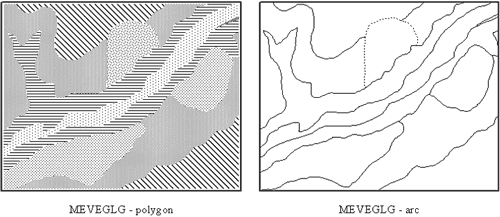
Digital Mapping Techniques '01 -- Workshop Proceedings
U.S. Geological Survey Open-File Report 01-223
Development of a Digital Geologic Map for Mesa Verde National Park
By Anne R. Poole1, Steve Fryer2, Tim Connors3, Bruce Heise4, Joe Gregson2, and Allan Loy5
1National Park Service
Intermountain GIS Center
University of New Mexico
Bandelier Hall West
Albuquerque, NM
Telephone: (505) 346-2885 x260
Fax: (505) 346-2889
e-mail: Anne_Poole@nps.gov
2National Park Service
Natural Resources Information Division
1201 Oak Ridge Drive, Suite 350
Fort Collins, CO 80525
Telephone: (970) 225-3584
Fax: (970) 225-3585
e-mail: Joe_Gregson@nps.gov
Steve_Fryer@nps.gov
|
|
3National Park Service
Geologic Resources Division
12795 West Alameda Parkway
P.O. Box 25287
Denver, CO 80225
Telephone: (303) 969-2093
Fax: (303) 987-6792
e-mail: Tim_Connors@nps.gov
4National Park Service
Geologic Resources Division
12795 West Alameda Parkway
P.O. Box 25287
Denver, CO 80225
Telephone: (303) 969-2017
Fax: (303) 987-6792
e-mail: Bruce_Heise@nps.gov
|
|
5GIS Operations
Mesa Verde National Park
P.O. Box 8
Mesa Verde, CO 81330
Telephone: (970) 529-4614
Fax: (970) 529-5028
e-mail: Allan_Loy@nps.gov
|
ABSTRACT
The maps shown on this poster were generated from digital geologic data for Mesa Verde National Park in Colorado. The data consist of several different coverages, each representing a different type of geologic feature (rock units, faults, etc.). The making of these coverages served as a pilot project for testing the National Park Service Digital Geologic Map model, which will eventually be used to create standardized Geologic Resource Inventories for 265 units of the National Park System.
THE NATIONAL PARK SERVICE DIGITAL GEOLOGIC MAP MODEL
Beginning in 1998, the National Park Service (NPS) initiated a geologic resources inventory to document and evaluate the geologic resources of 265 National Park System units (national parks, monuments, recreational areas, historic sites, seashores, etc.). A major part of this inventory is the compilation of digital geologic map products and their accompanying supporting information. To ensure uniform data quantity and quality, geologic-GIS data standards are being developed by the NPS Inventory and Monitoring (I&M) Program and Geological Resources Division (GRD). The challenge of this standardization is twofold:
- The standards must be adaptable to diverse geological conditions; and be capable of capturing all of the information present on a typical paper geologic map.
- The finished data must be "user-friendly"; that is, immediately useful to park resource managers and other staff, even those with little GIS or no geologic expertise.
The current version of the digital map model (Fryer et al., 2000) outlines a series of ArcInfo coverages. Each GIS layer represents a different type of geologic information digitized from the source map. While most of these layers consist of only one type of feature (point, line, or polygon), some, such as CODEGLG, include both line and polygon data. Accessory INFO tables hold additional data on rock unit type and age, and reference information on the source maps used to create the coverages. This model was originally developed from the Washington State ArcInfo GIS data model (Harris 1998) and has been extended to include components of the North American Geologic Map Data Model (Johnson et al., 1998).
It is the goal of the NPS Inventory and Monitoring Program to produce digital products that are immediately useful to anyone familiar with their analog counterparts - in this case, a paper geologic map. Therefore, each digital geologic map product will come with ArcView legend files that automatically display the proper shades and symbols for each data type. Map unit descriptions will also be automated by including them in a Windows Help File that can be linked with CODEGLG and other coverages in a customized ArcView project.
Some examples of geologic themes in the data model and the accessory data files to which they are linked are listed in Figure 1. In an actual geologic map for a park, the "CODE" portion of the coverage name is replaced by an official four-letter code used to identify each NPS unit (i.e. "MEVE" for Mesa Verde National Park). Figure 2 illustrates how certain coverages may contain both area (i.e. rock type) and line (contact type) features.

Figure 1. Some examples of geologic themes in the data model and the accessory data files to which they are linked.
|

Figure 2. Some coverages contain both polygon and arc features. For example, MEVEGLG stores information on both rock type and contact line type.
|
THE DIGITAL GEOLOGIC MAP OF MESA VERDE
Although it is not the intention of the National Park Service to initiate new mapping projects, this has become necessary in instances where adequate published maps do not exist. Such was the case for Mesa Verde National Park in southwestern Colorado. All previously published maps of the park lacked the desired level of detail, so the services of Mary O. Griffitts, a retired professional geologist and an expert on the local geology, were employed to create a new map at 1:24,000 scale. The resulting map sheets, drafted on mylar, were tablet digitized in ArcInfo to create coverages for the park's geologic inventory. For Mesa Verde these coverages included map units and their associated contacts, fault lines, joints, igneous dikes, non-igneous linear geologic features (in this case, travertine deposits along joints which were too thin to be mapped as polygons), and structural point data (i.e. strike and dip and other measurements/observations). Many other coverage types are outlined in the NPS map model, but were not deemed necessary for this park. A park with significant volcanic features, on the other hand, might make use of the ash unit (CODEASH) or volcanic point feature (CODEVNT) coverage types. Considering the wide variety of geologic resources that can be found in our national parklands, the model is being designed to be flexible enough to store any type of data that might be found on a geologic map.
Customized ArcView legend files (showing standardized symbology and/or colors pertaining to the age of the rock unit) were created and distributed along with the digital data to the park's GIS staff. When possible, these legends were given the same name as their associated coverage, so that they will load automatically when placed in the same directory as that coverage. These files are not only great timesavers but are also aids to anyone unfamiliar with either geologic data representation or the manipulation of the appearance of data in a GIS.
Rock type descriptions provided by Dr. Griffitts, as well as legend text from older maps of the area, were included in an accompanying Windows Help File, MEVEUNIT.HLP. In this file each map unit is listed on its own topic page, which is given an ID code identical to the unit's geologic symbol (which is also listed in the GLG_SYM field in certain coverages and hence serves as the link between coverage and help file). A contents page shows the names of all units in their proper stratigraphic order, and a references page lists sources from which the descriptions were derived. Keyword searches can be performed on this file using terms pertaining to lithology, formal unit names, time period, and other aspects. This help file, in addition to being useful on its own, is designed to be incorporated into the NPS Theme Manager, an ArcView extension developed to allow park staff with little GIS knowledge to access geographic data.
The new geologic resources inventory has been incorporated into Mesa Verde's GIS and has already been employed for post-wildfire geologic hazards studies. We anticipate that it will continue to prove its usefulness as new resource management issues arise.
REFERENCES
Fryer, Steve, Gregson, Joe, Connors, Tim, Poole, Anne, and Heise, Bruce, 2000, The National Park Service Digital Geologic Map Model: Transformation from paper to digital, featuring legends, cross sections, map notes, and keyword searchability, in D.R. Soller, ed., Digital Mapping Techniques '00 -- Workshop Proceedings: U.S. Geological Survey Open-File Report 00-325, p.69-81, https://pubs.usgs.gov/openfile/of00-325/fryer.html.
Harris, C.F.T., 1998, Washington State's 1:100,000-Scale Geologic Map Database: An ArcInfo Data Model Example, in D.R. Soller, ed., Digital Mapping Techniques '98 -- Workshop Proceedings: U.S. Geological Survey Open-File Report 98-487, p. 27-35, https://pubs.usgs.gov/openfile/of98-487/harris.html.
Johnson, B.R., Brodaric, Boyan and Raines, G.L., 1998, Draft Digital Geologic Map Data Model, Version 4.2: American Assoc. of State Geologists/U.S. Geological Survey Geologic Map Data Model Working Group, May 19, 1998, http://geology.usgs.gov/dm/model/Model42.pdf.
RETURN TO Contents
National Cooperative Geologic
Mapping Program | Geologic Division |
Open-File Reports
U.S. Department of the Interior, U.S. Geological Survey
URL: https://pubsdata.usgs.gov/pubs/of/2001/of01-223/poole.html
Maintained by David R. Soller
Last modified: 18:24:58 Wed 07 Dec 2016
Privacy statement | General disclaimer | Accessibility

